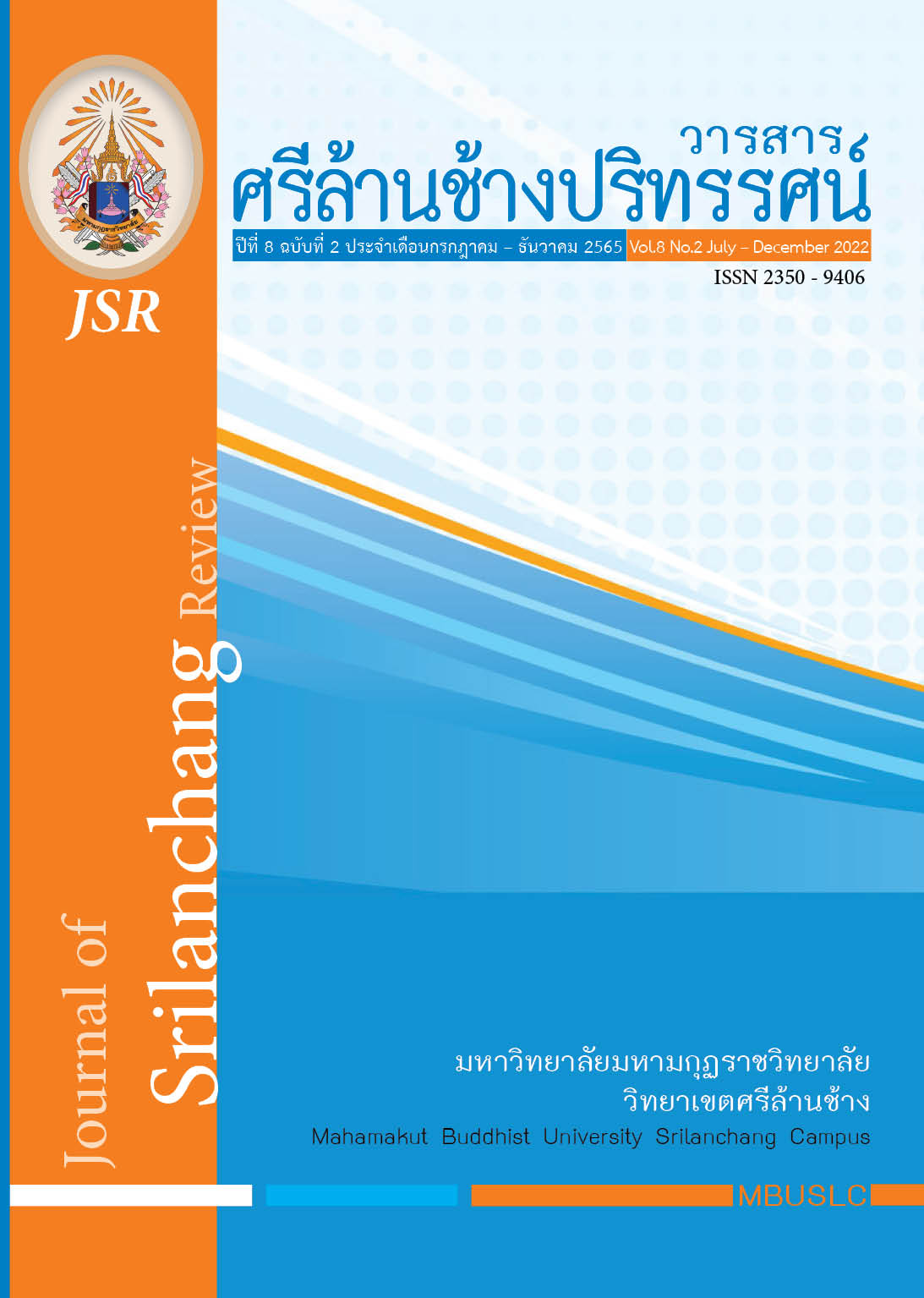Buddhism innovation creativity : four requisites
Main Article Content
Abstract
The objective of the article was to demonstrate the Buddha's innovative creativity on what was accepted as a practical example or an innovation that was derived from the creation of new knowledge, and thinking and implementation of the knowledge in accordance with the situations in the Buddha’s time. There were several samples on Buddhist innovations on administration, learning management, and disciplinariness. In the article, it was clearly said about a creative innovation of four requisites for monks; clothing or three robes (Civara in Pali), food or alms food (Pindapata in Pali), abiding (Senasana in Pali), and medicine (Gilanabhesajja in Pali). Each of them reflected the Buddha’s innovative creativity. In terms of clothing, for instance, the Buddha gave Venerable Ananda only a hint, but the existing three robes for monks were under the processes of invention, design, development and implementation. As regards, new knowledge was created and utilized in line with the existing situation. That was, three robes for Buddhist monks were cut in pieces and sew together like the formation of Magadha farmers’ fields. Therefore, a Magadha-field-designed robe became a new invention, of which the most significant advantage was that such a robe was no longer stolen, and Buddhist monks could dress themselves in so-called three robes without any worries. Nevertheless, they become clothes for Buddhist monks, allowed by the Buddha, until now.
Article Details

This work is licensed under a Creative Commons Attribution-NonCommercial-NoDerivatives 4.0 International License.
บทความที่ได้รับการพิจารณาจากคณะกรรมการผู้ทรงคุณวุฒิและเผยแผ่ในวารสารฉบับนี้ เป็นทัศนคติและข้อคิดเห็นส่วนบุคคลของผู้เขียนแต่ละท่าน ไม่ถือว่าเป็นทัศนะคติและความรับผิดชอบ
ของบรรณาธิการ
บทความ ข้อมูล เนื้อหา รูปภาพ ฯลฯ ที่ได้รับการตีพิมพ์ในวารสารศรีล้านช้างปริทรรศน์ ถือเป็นลิขสิทธิ์ของวารสารศรีล้านช้างปริทรรศน์ หากบุคคลหรือหน่วยงานใดต้องการนำทั้งหมดหรือส่วนหนึ่งส่วนใดไปเผยแพร่ต่อหรือเพื่อกระทำการใด ๆ จะต้องได้รับอนุญาตเป็นลายลักอักษรจากวารสารศรีล้านช้างปริทรรศน์ ก่อนเท่านั้น
References
กรมการศาสนา. (2525 ก). พระไตรปิฎกภาษาไทย ฉบับหลวง เล่มที่ 1 พระวินัยปิฎก เล่มที่ 1 มหาวิภังค์ ภาค 1. พิมพ์ครั้งที่ 4. กรุงเทพฯ: กระทรวงศึกษาธิการ
กรมการศาสนา. (2525 ข). พระไตรปิฎกภาษาไทย ฉบับหลวง เล่มที่ 4 พระวินัยปิฎก เล่มที่ 4 มหาวรรค ภาค 1. พิมพ์ครั้งที่ 4. กรุงเทพฯ: กระทรวงศึกษาธิการ
กรมการศาสนา. (2525 ค). พระไตรปิฎกภาษาไทย ฉบับหลวง เล่มที่ 5 พระวินัยปิฎก เล่มที่ 5 มหาวรรค ภาค 2. พิมพ์ครั้งที่ 4. กรุงเทพฯ: กระทรวงศึกษาธิการ
กรมการศาสนา. (2525 ง). พระไตรปิฎกภาษาไทย ฉบับหลวง เล่มที่ 7 พระวินัยปิฎก เล่มที่ 7 จุลวรรค ภาค 2. พิมพ์ครั้งที่ 4. กรุงเทพฯ: กระทรวงศึกษาธิการ
กรมการศาสนา. (2525 จ). พระไตรปิฎกภาษาไทย ฉบับหลวง เล่มที่ 9 พระสุตตันตปิฎก เล่มที่ 1 ทีฆนิกาย สีลขันธวรรค. พิมพ์ครั้งที่ 4. กรุงเทพฯ: กระทรวงศึกษาธิการ
กรมการศาสนา. (2525 ฉ). พระไตรปิฎกภาษาไทย ฉบับหลวง เล่มที่ 12 พระสุตตันตปิฎก เล่มที่ 4 มัชฌิมนิกาย มูลปัณณาสก์. พิมพ์ครั้งที่ 4. กรุงเทพฯ: กระทรวงศึกษาธิการ
กรมการศาสนา. (2525 ช). พระไตรปิฎกภาษาไทย ฉบับหลวง เล่มที่ 20 พระสุตตันตปิฎก เล่มที่ 12 อังคุตตรนิกาย เอก-ทุก-ติกนิบาต. พิมพ์ครั้งที่ 4. กรุงเทพฯ: กระทรวงศึกษาธิการ
กรมการศาสนา. (2525 ซ). พระไตรปิฎกภาษาไทย ฉบับหลวง เล่มที่ 25 พระสุตตันตปิฎก เล่มที่ 17 ขุททกนิกาย ขุททกปาฐะ-ธรรมบท-อุทาน-อิติวุตตกะ-สุตตนิบาต. พิมพ์ครั้งที่ 4. กรุงเทพฯ: กระทรวงศึกษาธิการ
ทองย้อย แสงสินชัย. (2565). พุทธนวัตกรรมคือทำอะไร ใครรู้บ้าง. ออนไลน์. สืบค้นเมื่อ 1 กรกฎาคม 2565 แหล่งข้อมูล http://dhamma.serichon.us/2021/06/14
พระธรรมปิฎก (ป. อ. ปยุตโต). (2546). พจนานุกรมพุทธศาสตร์ ฉบับประมวลธรรม. พิมพ์ครั้งที่ 12. กรุงเทพฯ: สำนักพิมพ์ผลิธัมม์
พระราชปริยัติกวี (สมจินต์ สฺมาปญฺโญ). (2561). ชูพุทธนวัตกรรมของมหาจุฬาฯ แก้ปัญหาสังคม. การประชุมวิชาการระดับชาติ เมื่อวันที่ 9 กันยายน พ.ศ. 2561. ออนไลน์. สืบค้นเมื่อ 1 กรกฎาคม 2565 แหล่งข้อมูล https://www.banmuang.co.th/news/education/124551
มหาจุฬาลงกรณราชวิทยาลัย. (2539). พระไตรปิฎกภาษาไทย ฉบับมหาจุฬาลงกรณราชวิทยาลัย. กรุงเทพมหานคร: โรงพิมพ์มหาจุฬาลงกรณราชวิทยาลัย.
ราชบัณฑิตยสถาน. (2546). พจนานุกรม ฉบับราชบัณฑิตยสถาน พ.ศ. 2542. พิมพ์ครั้งที่ 1. กรุงเทพมหานคร: นานมีบุคส์พลับลิเคชั่น
วิชัย วงษ์ใหญ่ และ มารุต พัฒผล. (2562). การพัฒนาทักษะสร้างสรรค์นวัตกรรม. กรุงเทพมหานคร: ศูนย์ผู้นำนวัตกรรมหลักสูตรและการเรียนรู้
แสวง อุดมศรี. (2549). พระวินัยปิฎก 1 ว่าด้วยมหาวิภังค์หรือภิกษุวิภังค์. กรุงเทพฯ: ประยูรวงค์พริ๊นท์ติ้ง


